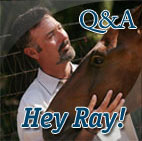More Pattern Exercises..Part 2
 24th in a series
24th in a series
Last issue, Les introduced pattern exercises to reinforce communication. Here are some additional ones.
Cones
Setting out cones in a straight line (about 10 to 12 feet apart) can give you a whole myriad of exercises to work on. Make sure to think and look ahead when you are doing them, and think of steering the motorboat. So instead of thinking about the next step, you should be thinking about, and positioning him for, where he will need to be five steps from now.
Pattern Exercises…Part 1
 23rd in a series
23rd in a series
After helping readers with communication and rewarding, Les gives us some steering drills to reinforce our progress.
If you’re not happy with your horse’s steering at this point, here are some patterns you can incorporate into your ride to give you both more practice. If I were standing there watching you, I could tell you what you needed to work on, but since your’re out on your own, these exercises will help to uncover problems so you can fix them.
How fast can you reward your horse?
 22nd in a series
22nd in a series
After showing readers some techniques to teach your horse about bit pressure, Les give us a look at providing feedback.
The better you get at rewarding your horse for the correct response or even the correct thought, the faster he is going to progress through this program. This means that before he can be trained, you need to become trained. You need to get to the point where your hands respond to the presence and absence of resistance in your horse’s mouth, almost before your brain comprehends it. Think for a minute about when you drive a car (or, for our younger readers, ride a bicycle). When you come to a curve in the road, do you mentally stop and think about how you’re going to make it around the corner before you actually start to move the wheel? Probably not if you’ve been driving for more than a few months. Your riding has to start to become the same way:
Flexion: Experimenting with rein position
 20th in a series
20th in a series
After reviewing lateral flexion in detail last issue at a standstill, Les refines the exercise ever further.
Once your horse is giving his head readily to the side from fairly light pressure, it might be a good time to experiment a little with how the position of your direct rein hand affects your horse. Although different horses will respond a little differently depending on conformation, you will find some general consistencies.
Lateral Flexion: At a Standstill
 Nineteenth in a series
Nineteenth in a series
After looking at lateral flexion at the walk, jog and lope last issue, Les looks at the standstill.
This exercise is designed to limber and stretch the horse’s neck and shoulders. It may be uncomfortable at first for older or thick-necked horses, but that’s all the more reason you should spend time on it. In the long run, it will really help your horse’s balance and agility.
Lateral flexion: Colt starting
 Eighteenth in a series
Eighteenth in a series
After our detailed look last issue at side-to-side rein pressure, Les demonstrates the practice when starting a colt.
When you are starting a colt, you show him how to respond to a rein by pulling it out to the side and directing him. As soon as he starts to get it you’ll want to start keeping your hands closer to your body and to literally pick up the rein to initiate the bend. This will encourage him to keep his chin closer to his body like we want, rather than sticking his nose out to the side. Lifting up the hand also encourages your horse to keep his shoulders up rather than leaning into the turn, another concept that will become critical further down the line.
Lateral Flexion: Exercise #1
 Seventeenth in a series
Seventeenth in a series
After our closer look at flexion in last issue, Les looks in detail at side-to-side rein pressure.
Even if you have a trained horse that you’ve ridden for years, it’s important that you don’t skip this section. If you’re tempted, ask yourself these questions – 1) when I start to pick up one rein, does my horse start to give his nose BEFORE I’ve taken all the slack out of that rein? And 2) when my horse turns his head in response to rein pressure, does he bend his whole neck and keep his head more or less perpendicular to the ground and level with his withers, or does he twist his neck and just stick his nose toward the direction I’m pulling him?
If he doesn’t respond to your lateral, or side-to-side, rein pressure from a light cue and with proper form, you’ll never get the soft vertical flexion you need for the high-performance events. So stick with us – this “retraining” alone might have a profound effect on your horse’s performance.
The Procedure
Here’s the procedure: As you are walking along in a straight line, pick up one rein and make soft contact with the bit. If your horse doesn’t immediately start to yield, initiate the bend by pressing with your inside leg (the same side as the rein you are picking up) while you softly work the corner of the horse’s mouth by just squeezing your fingers like you would squeeze a sponge.
Release and Reward
At first, you’ll want to release the rein pressure as soon as the horse gives to your hand – so he understands that’s all that you wanted, and that it was really easy. If he starts to give when he feels you pick up the rein, you may even stop and just praise him. As always they will learn the quickest when you are consistent with your cues, and you make it very clear when they’ve done right by releasing the pressure and rewarding their effort.
Twisted Head = Twisted Spine
If your horse responds to your rein pressure by twisting his head rather than bending his neck, you’re going to need to use your indirect rein to keep his nose in and down as he turns. To help you understand the difference, think of it this way: If the form is correct the horse’s ears should stay close to level as he bends his neck around. If he’s twisting his head you will see the outside ear dropping as his head moves sideways. This may seem minor now but this form will become really critical when you start to do turnarounds. If the horse’s neck is twisted it will not only be harder for him to step around the turn with the outside front leg, but it will send his weight to the outside hind leg rather than to the inside pivot foot. So as you can see, achieving the correct form now will pay off in spades as your training progresses.
Start With the Inside Rein
Another thing you want to be conscious of is that you try to keep your horseÕs head about level with his withers, or even lower, as he turns it from side to side. You don’t want him to lift; you just want him to turn. If he does start to lift or twist his head, try bumping him just enough with the outside rein to get his nose down as he turns. Since our goal is for the horse to initiate the correct form on his own, always start your flexions with just the inside rein, and then add the outside one only if he gets out of form.
EDITOR’S NOTE: More with Les is a regular California Horsetrader column. Les Vogt has won more than 15 World Championships, including two wins at the NRCHA Snaffle Bit Futurity. Although Les still rides and occasionally shows, his focus is giving clinics around the world and developing products for the performance horseman. To learn more about Les and to see his clinic schedule, visit: www.lesvogt.com
Lateral & Vertical Flexion Defined
 Sixteenth in a series
Sixteenth in a series
Now that we’ve worked on resistance in our hands, Les reviews flexion.
In riding terms, flexion is when a horse gives you a smooth, yielding response to a rein cue. In order to do this, of course, the horse’s neck has to be relaxed and supple. When we refer to lateral flexion, it is when the horse willingly and smoothly yields his nose from side to side as a result of direct rein pressure. Later, we will be working on vertical flexion, which is when the horse yields his nose down and back, bending his neck, in response to rein pressure.
Spending lots of time developing lateral flexion here at this level is going to be the best way to get vertical flexion later on because it conditions the horse to yield to light pressure on the bit, and the side-to-side movement is easy for him to understand. If you’ve really done your lateral work until it’s perfect, when you pick up with both of your hands to ask for vertical flexion, your horse should respond quite willingly. If not, the best remedy is more lateral, or side-to-side, work.
EDITOR’S NOTE: More with Les is a regular California Horsetrader column. Les Vogt has won more than 15 World Championships, including two wins at the NRCHA Snaffle Bit Futurity. Although Les still rides and occasionally shows, his focus is giving clinics around the world and developing products for the performance horseman. To learn more about Les and to see his clinic schedule, visit: www.lesvogt.com
Train Hands to Feel for Resistance
 Fifteenth in a series
Fifteenth in a series
After honing a relaxed seat last issue, Les has us focus on the feel in our hands.
Every time you ride, be conscious of whether you’re letting your horse pull on your hands or not. There are two situations where you will feel resistance and you need to train yourself so that alarms go off in your head when they happen. First is when you pick up on a rein and feel resistance; that is, your horse doesn’t give right away to the pressure; and second is when the horse takes the slack out of the rein and starts leaning on you. Any time you feel resistance, you need to instinctively start working the snaffle in his mouth, until the resistance goes away and he gives his head with a soft poll. You don’t have to tug or pull, just move the snaffle back and forth with enough pressure to remind your horse it’s in his best interest to give to you and soften his poll.
Staying Relaxed in the Saddle
 Fourteenth in a series
Fourteenth in a series
After looking at ways toward a lighter touch in our hands last issue, Les coaches us on our seat.
When you see an equine athlete performing, you’ll notice that although they exhibit tremendous power, every movement is fluid and relaxed. There is no tension or stiffness anywhere. If this type of performance is your ultimate goal, the first thing you need to check on is your own riding. When you ride are you fluid and relaxed, with no tension or stiffness anywhere? Many novice riders get so focused on a particular movement that they end up carrying a lot of tension in different parts of their body, shoulders in particular. Stiffness in the rider results in movements and cues that are laborious and abrupt instead of smooth and flowing, and this will result in resistance and stiffness in the horse’s movements as well. This is why many of the exercises in this first section are designed to help you develop your feel and learn to stay relaxed in the saddle.



 Read Columns
Read Columns

